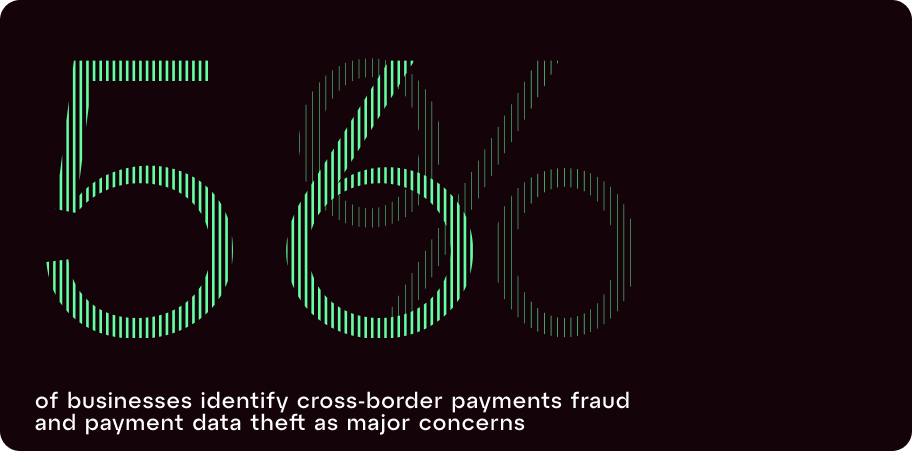Publication date
Share this article
Doing business across borders is becoming increasingly common for companies, and it's here to stay. In fact, cross-border payments hit a record high of $156 trillion last year, offering significant opportunities for small and medium-sized enterprises (SMEs) in the international market.
But let's face it, international payments can be a real headache. They bring frustration, financial burdens and even security concerns for businesses. Luckily, we can help you to address these challenges head-on.
In this article, we'll dive into the common hurdles you’re likely to face with cross-border payments, and how you can overcome them efficiently.
Why are cross-border payments so challenging?
Extra costs
Regulatory costs, transaction fees and ridiculously high foreign-exchange rates margins can significantly drive up the overall cost of international payments. These fees vary across banks and transactions, leaving businesses in the dark over how much a transaction will set them back. Adding insult to injury, the common lack of transparency in pricing is a major pain point, often leading to unpleasant surprises that dent a company's budget.
Delays
When it comes to cross-border transfers, traditional banks take their sweet time, typically requiring three-to-five days to process a transfer. It's a stark contrast to the near-instantaneous domestic transfers we're used to. So what's causing all this delay?
Well, there are several factors at play, such as increased regulations, time zone differences and currency conversions. And let's not forget about intermediary banks that also play a part in dragging things out. Did you know that if you're sending money from the UK to China, it might have to make a detour through banks in the US and Canada before finally reaching its destination? Talk about taking the scenic route!
Visibility
One major frustration businesses have with international transactions is the difficulty in tracking their funds. When you send a payment through a traditional bank, it seems to vanish into a black hole of the correspondent banking network. Not only are you left in the dark with no clue where your payment is, but this lack of visibility makes it incredibly difficult to catch any failed payments, stay on top of your cash flow and make sure your suppliers are paid on time. It's frustrating, to say the least!
Security

Fraud is also a big concern for business owners. A whopping 56% of businesses identify cross-border payments fraud and payment data theft as major concerns. It's a real issue, and unfortunately, cross-border payment systems often end up being targeted by sneaky fraudsters. But why does this happen?
Well, one reason is that the international payments system is quite fragmented with different players involved, which creates more opportunities for vulnerabilities. On top of that, every country has its own rules and regulations for banks and payment providers. This means that the level of security controls can vary, leaving gaps that those fraudsters are quick to exploit.
Moreover, many businesses lack the necessary resources or in-house expertise to effectively tackle fraud, making it a challenging battle.
To minimise cross-border transaction problems in your business, it's also important to be aware of the common pitfalls. Check out our article, where we cover all the easily avoidable mistakes you need to sidestep: Common mistakes to avoid when making cross-border payments.
Overcoming cross-border transactions obstacles with iBanFirst
Don't let cross-border payment complexities hinder your business from reaching its global potential. While industry-wide challenges like delays, security risks and limited transparency prevail, iBanFirst offers a game-changing cross-border payment experience, combining a powerful platform with the support of top FX experts.
With iBanFirst, you can collect, convert and send funds efficiently across 140+ countries while protecting your business from currency market volatility.
Swift and reliable payments
Leveraging our extensive network of local and global financial partners, we ensure that your business benefits from the speediest and most cost-effective cross-border payment routes, every single time.
Tracking made easy
Say goodbye to the uncertainty of your payment's whereabouts. With the iBanFirst Payment Tracker, you'll have complete visibility over your payments, with live updates every step of the way. No more surprises or unexpected delays, giving you full control over your financial operations.
Fair and transparent pricing
At iBanFirst, we understand the importance of fair and transparent pricing for small and medium-sized businesses. From day one, we've prioritised providing highly competitive exchange rates in real-time. What's more, we show you the total costs upfront, leaving no room for hidden fees that could disrupt your budget.
A partner you can trust
Fully licensed and regulated as a Payment Service Provider (PSP) in Europe and in the UK, iBanFirst is a member of SWIFT and SEPA certified. To protect your funds and data, we implement enterprise-grade data encryption and multi-layered security controls.
Ready to embrace the future of cross-border payments? Talk to our experts to find out more about how iBanFirst can help you manage your cross-border transactions with ease.
Topics






